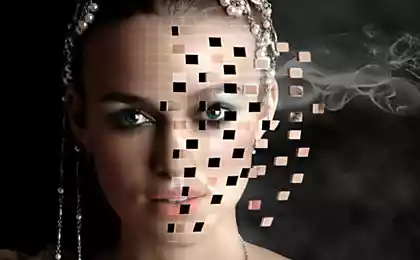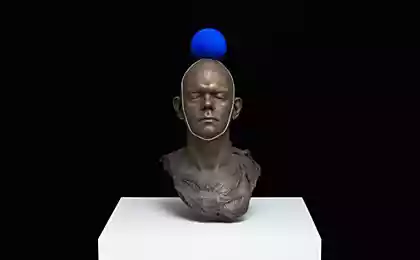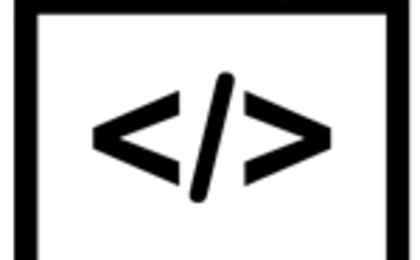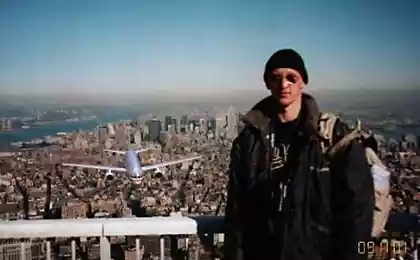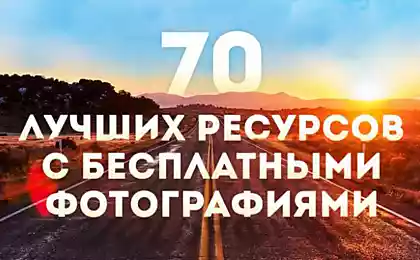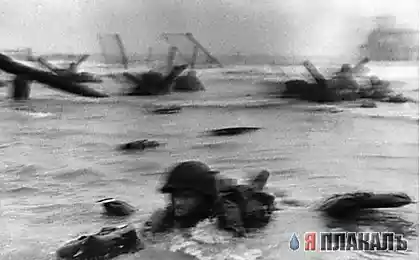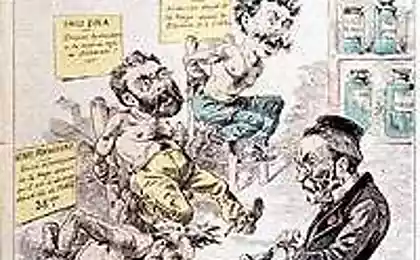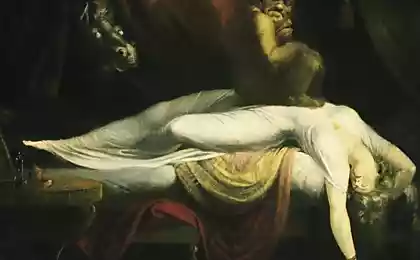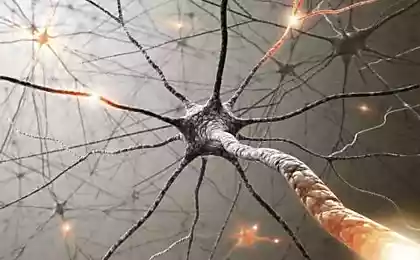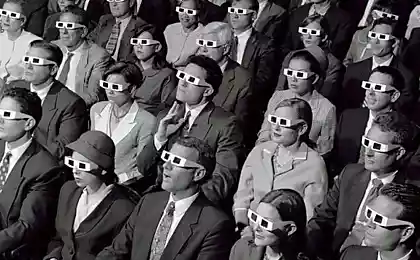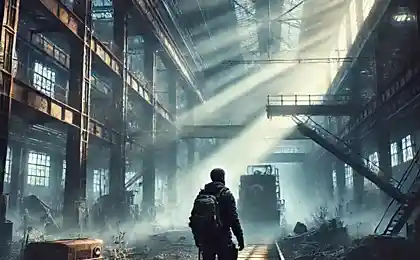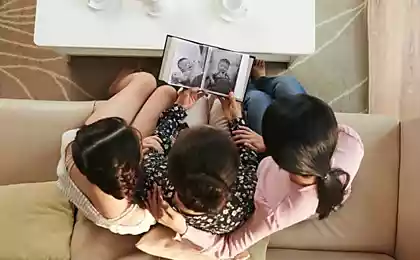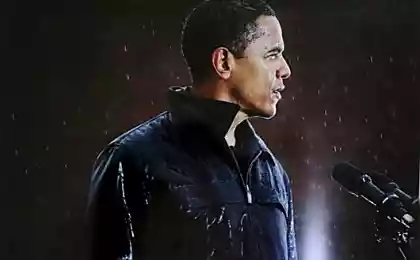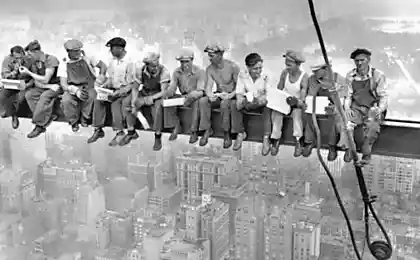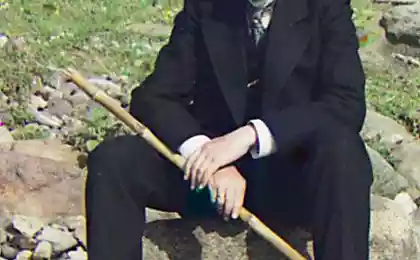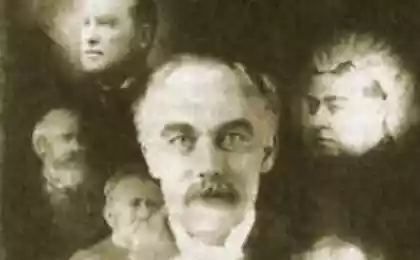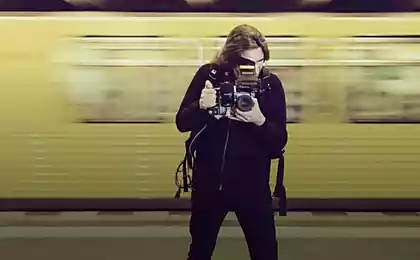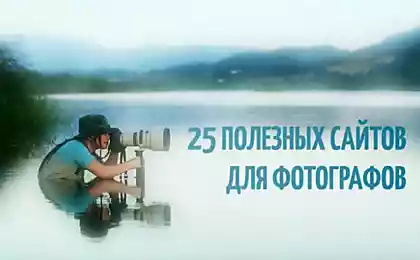2561
Photos of hallucination (8 photos)
Even in the XIX century, researchers have found an interesting fact - visual hallucinations are subject to physical laws of refraction of light.
So, in 1885, Binet and Fere noticed doubling hallucinatory images in space in patients with pressure on the eyes and the oversight of them prism.
Later, in 1903, found the following Shterring. If the patient is looking through binoculars, the vision seemed to her more intimate, or, conversely, remote. It all depended on whether she puts to the eye or ocular lens.
Despite the fact that the described phenomena have been repeatedly documented, scientific explanation for them no one gave.
In 1973, 32-year-old psychiatrist from Perm Gennady Krokhalev took experimentally confirm existed for decades version, namely the visual images in the brain and transmitted to the retina of the eye, where the radiated into space. With the help of a specially designed device Krokhaleva them on several hundred patients succeeded brilliantly in practice to confirm this hypothesis.
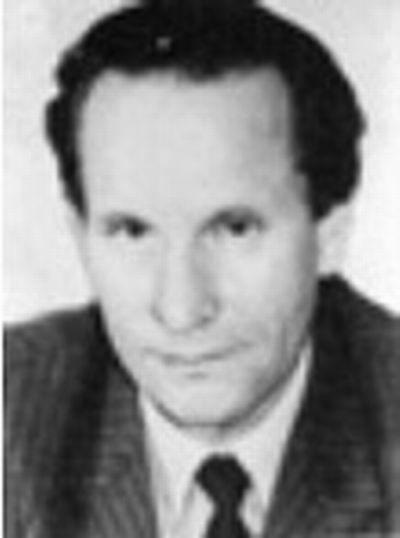
FAQ:
Gennady Krokhalev born 12 August 1941 in the Perm region. In 1965 he graduated from Perm Medical Institute. From 1967 he worked as a psychiatrist in the Perm regional psychiatric hospital № 1. His work has received wide international recognition.
Here's what he said about his experiments:
"We have hypothesized that the visual hallucinations postback occurs visual information (from the center of the visual analyzer to peripheral receptive) with electromagnetic radiation with visualized images of the retina in space, enabling objective registration of these images by photographing.
We set out to test the possibility of objective registration of images visualized with visual hallucinations using cameras, camera and flat negative film in black opaque packages.
Since 1974, I manage to photograph visual hallucinations in psychiatric patients, mostly - with delirium tremens. (Delirium tremens (delirium tremens, delirium tremens) - alcoholic psychosis flowing in the form of hallucinatory pomrachneniya consciousness dominated by true visual hallucinations, delusional disorders, affective volatile, followed by motor excitation and safety awareness.) Our hypothesis was confirmed experimentally.
Photographing visualized images with visual hallucinations was conducted in 203 mentally ill.
Photographing visual hallucinations held movie camera "Lanthanum" using a mask for snorkeling. Instead of glass in the mask was set stretching fur on camera "Fotokor", and to a narrowing of the tightly connect camera lens. The mask worn on the face of the mentally ill, and photography was carried out in complete darkness.
Photographing visual hallucinations was conducted at a distance of 25-45 cm from the eye of the patient. This simple technique makes it possible to photograph visual hallucinations in any branch of the mental hospital, because mask protects the patient's eyes from any external light. During photographing nurse carried out simultaneous recording hallucinatory experiences of patients on special cards. At the end of these experiments have been carried out and the control experiments in which as subjects attended health workers, hospital staff. Control survey was conducted using the same film and the same mask. Each card has a specially filled with signature doctor who carried out the experiment.
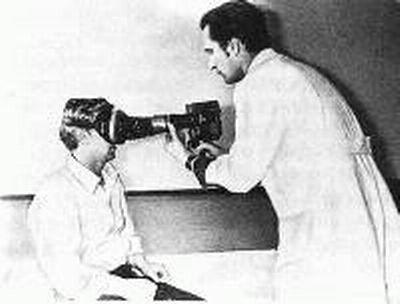
Another way - photographing visual hallucinations held flat film negative (13 x 18 cm) sensitivity 65, 130, 400, 900 units. And infrahro-matical photographic plates (9 x 12 cm) "Infra-740", which were opaque black bag. During these visual hallucinations film in black bags trays to patients and kept at a distance of 20-35 cm from the eye for 10-15 seconds. Patients were asked to describe what they see on the black bag. A nurse at the end of the experience fills a special card, which drifts hallucinatory experiences of the patient. Control experiments were carried out under the same conditions.
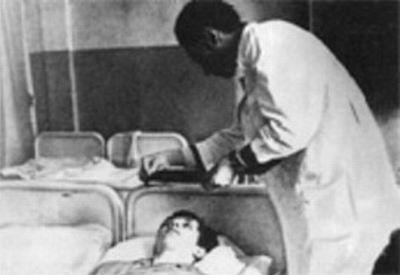
Photographing visual hallucinations conducted in 78 mentally ill. Positive results were obtained in 40 (from frame to clear the weak illumination). We obtain the following photographs of visual hallucinations: "familiar people at the table", "the girl's face," "the old woman with a long nose", "white light", "bright image crescent", "lion", "fly", "unit", "cat "," Puss in Boots "," cover "," nail "," giraffe "," square "," brother "," devil "," beetle "," jellyfish "," point "," mausoleum "," plane "," brass band "," monument "," church "," spire of the Admiralty, "" a bottle of vodka "," human face "," dolphin "," moon ».
All positive results were obtained when the next matching pattern: the lens aperture is almost completely open, the focal length - "infinity».
Part of the photos was shown the recovered patients who have confirmed their gallyutsinatsii.Kontrolnye footage flare had .. »
Of all these shots managed to find quite a bit:
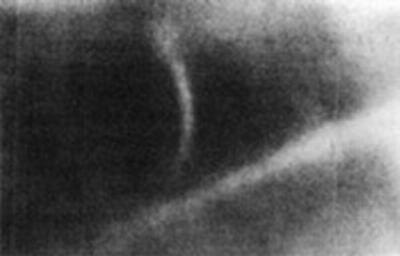
"The image of the crescent».
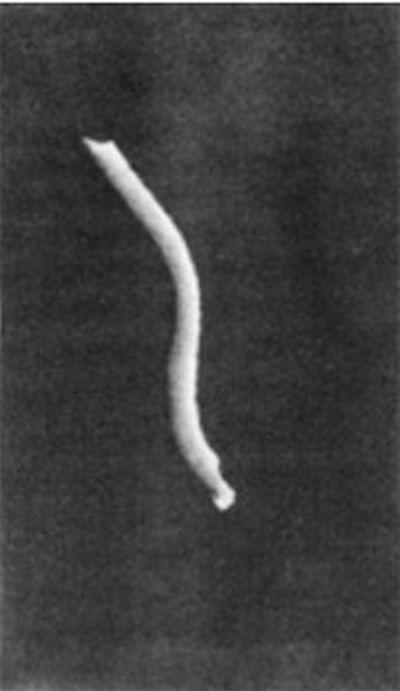
"Unit».
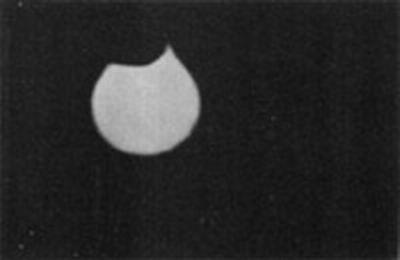
«Moon».
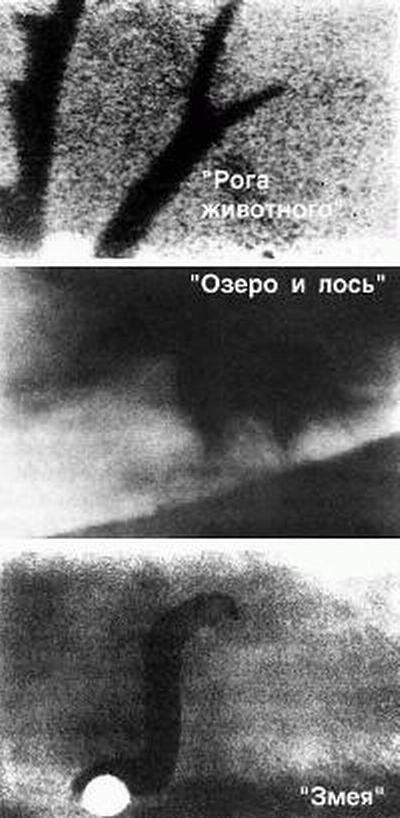
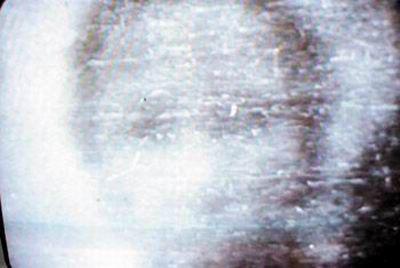
In January 1977 Committee on discoveries and inventions received from GP Krokhaleva application to open for the number of 32-OT-9465 "Shaping eye holographic images in the space of visual hallucinations." In July of the same year, the above-mentioned institution has adopted a second version of the application for the opening number for the 32-OT-9363 "Formation of the brain in the space of visual hallucinations».
After a while the author was the laconic reply: "Your application ... can not be taken into consideration because of its lack of conclusive evidence of the claimed authenticity of your position».
Attitude to innovators in the USSR was the same as in shame sad past with heretics-Cybernetics. It is therefore a priority as it disappeared, did not become registered domestic opening.
By 1990, Gennady in their study had 33 publications in different countries (USSR, Japan, Germany, Czechoslovakia, Poland, USA and others.). His works published about 80 articles and was shot six documentaries.
In spring 1991 G. Krokhaleva a call from Moscow and asked to send all materials to photograph visual hallucinations in 17 years (from 1974 to 1991). Researchers assured that only in this case the laboratory will be allocated several million rubles. As you would expect, no money, no material no one else in Perm not see.
In his latest publication Gennady wrote, "reports the following data: in 1977 Zdenek-Reydan, president of the International Association for the psychotronic published my article in Japan sensational" Photographing visual hallucinations "(Proceedings of the 3rd International Congress on psychotronic, 1977, t . 2, pp. 487-497, Tokyo) in Russian! And my research in Japan were classified ...
Krokhalev developed intense activity: writing books, giving interviews, going to apply for a new discovery, which, according to him, was to bring him the Nobel Prize, but it was for the discovery we'll never know ...
In April 1998, Gennady Krokhalev suddenly all committed suicide.
So, in 1885, Binet and Fere noticed doubling hallucinatory images in space in patients with pressure on the eyes and the oversight of them prism.
Later, in 1903, found the following Shterring. If the patient is looking through binoculars, the vision seemed to her more intimate, or, conversely, remote. It all depended on whether she puts to the eye or ocular lens.
Despite the fact that the described phenomena have been repeatedly documented, scientific explanation for them no one gave.
In 1973, 32-year-old psychiatrist from Perm Gennady Krokhalev took experimentally confirm existed for decades version, namely the visual images in the brain and transmitted to the retina of the eye, where the radiated into space. With the help of a specially designed device Krokhaleva them on several hundred patients succeeded brilliantly in practice to confirm this hypothesis.

FAQ:
Gennady Krokhalev born 12 August 1941 in the Perm region. In 1965 he graduated from Perm Medical Institute. From 1967 he worked as a psychiatrist in the Perm regional psychiatric hospital № 1. His work has received wide international recognition.
Here's what he said about his experiments:
"We have hypothesized that the visual hallucinations postback occurs visual information (from the center of the visual analyzer to peripheral receptive) with electromagnetic radiation with visualized images of the retina in space, enabling objective registration of these images by photographing.
We set out to test the possibility of objective registration of images visualized with visual hallucinations using cameras, camera and flat negative film in black opaque packages.
Since 1974, I manage to photograph visual hallucinations in psychiatric patients, mostly - with delirium tremens. (Delirium tremens (delirium tremens, delirium tremens) - alcoholic psychosis flowing in the form of hallucinatory pomrachneniya consciousness dominated by true visual hallucinations, delusional disorders, affective volatile, followed by motor excitation and safety awareness.) Our hypothesis was confirmed experimentally.
Photographing visualized images with visual hallucinations was conducted in 203 mentally ill.
Photographing visual hallucinations held movie camera "Lanthanum" using a mask for snorkeling. Instead of glass in the mask was set stretching fur on camera "Fotokor", and to a narrowing of the tightly connect camera lens. The mask worn on the face of the mentally ill, and photography was carried out in complete darkness.
Photographing visual hallucinations was conducted at a distance of 25-45 cm from the eye of the patient. This simple technique makes it possible to photograph visual hallucinations in any branch of the mental hospital, because mask protects the patient's eyes from any external light. During photographing nurse carried out simultaneous recording hallucinatory experiences of patients on special cards. At the end of these experiments have been carried out and the control experiments in which as subjects attended health workers, hospital staff. Control survey was conducted using the same film and the same mask. Each card has a specially filled with signature doctor who carried out the experiment.

Another way - photographing visual hallucinations held flat film negative (13 x 18 cm) sensitivity 65, 130, 400, 900 units. And infrahro-matical photographic plates (9 x 12 cm) "Infra-740", which were opaque black bag. During these visual hallucinations film in black bags trays to patients and kept at a distance of 20-35 cm from the eye for 10-15 seconds. Patients were asked to describe what they see on the black bag. A nurse at the end of the experience fills a special card, which drifts hallucinatory experiences of the patient. Control experiments were carried out under the same conditions.

Photographing visual hallucinations conducted in 78 mentally ill. Positive results were obtained in 40 (from frame to clear the weak illumination). We obtain the following photographs of visual hallucinations: "familiar people at the table", "the girl's face," "the old woman with a long nose", "white light", "bright image crescent", "lion", "fly", "unit", "cat "," Puss in Boots "," cover "," nail "," giraffe "," square "," brother "," devil "," beetle "," jellyfish "," point "," mausoleum "," plane "," brass band "," monument "," church "," spire of the Admiralty, "" a bottle of vodka "," human face "," dolphin "," moon ».
All positive results were obtained when the next matching pattern: the lens aperture is almost completely open, the focal length - "infinity».
Part of the photos was shown the recovered patients who have confirmed their gallyutsinatsii.Kontrolnye footage flare had .. »
Of all these shots managed to find quite a bit:

"The image of the crescent».

"Unit».

«Moon».


In January 1977 Committee on discoveries and inventions received from GP Krokhaleva application to open for the number of 32-OT-9465 "Shaping eye holographic images in the space of visual hallucinations." In July of the same year, the above-mentioned institution has adopted a second version of the application for the opening number for the 32-OT-9363 "Formation of the brain in the space of visual hallucinations».
After a while the author was the laconic reply: "Your application ... can not be taken into consideration because of its lack of conclusive evidence of the claimed authenticity of your position».
Attitude to innovators in the USSR was the same as in shame sad past with heretics-Cybernetics. It is therefore a priority as it disappeared, did not become registered domestic opening.
By 1990, Gennady in their study had 33 publications in different countries (USSR, Japan, Germany, Czechoslovakia, Poland, USA and others.). His works published about 80 articles and was shot six documentaries.
In spring 1991 G. Krokhaleva a call from Moscow and asked to send all materials to photograph visual hallucinations in 17 years (from 1974 to 1991). Researchers assured that only in this case the laboratory will be allocated several million rubles. As you would expect, no money, no material no one else in Perm not see.
In his latest publication Gennady wrote, "reports the following data: in 1977 Zdenek-Reydan, president of the International Association for the psychotronic published my article in Japan sensational" Photographing visual hallucinations "(Proceedings of the 3rd International Congress on psychotronic, 1977, t . 2, pp. 487-497, Tokyo) in Russian! And my research in Japan were classified ...
Krokhalev developed intense activity: writing books, giving interviews, going to apply for a new discovery, which, according to him, was to bring him the Nobel Prize, but it was for the discovery we'll never know ...
In April 1998, Gennady Krokhalev suddenly all committed suicide.
